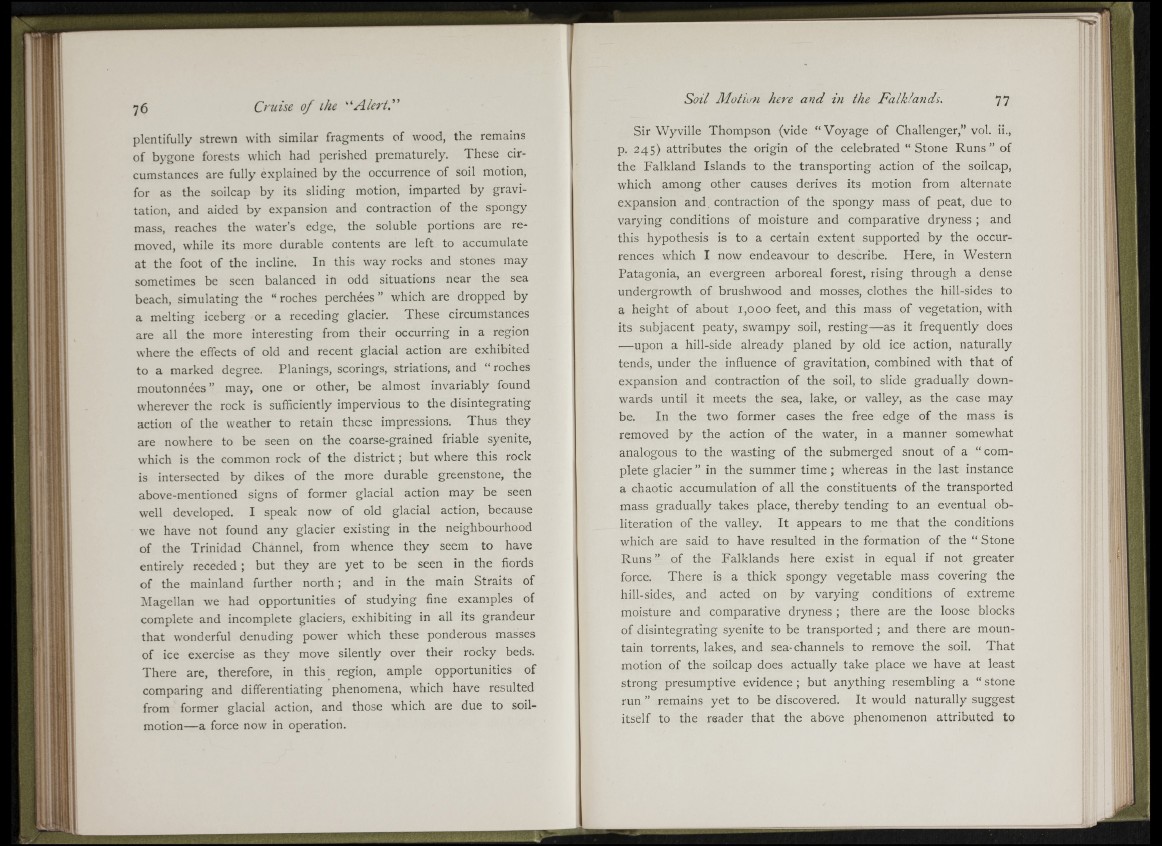
dâm
I IfW'' t'rÿjC=
’ W ' -
r * :
i i [ IBS .«Bf 1
H
i - iii
l:
il
plentifully strewn with similar fragments of wood, the remains
of bygone forests which had perished prematurely. These circumstances
are fully explained by the occurrence of soil motion,
for as the soilcap by its sliding motion, imparted by gravitation,
and aided by expansion and contraction of the spongy
mass, reaches the water’s edge, the soluble portions are removed,
while its more durable contents are left to accumulate
at the foot of the incline. In this way rocks and stones may
sometimes be seen balanced in odd situations near the sea
beach, simulating the “ roches perchées” which are dropped by
a melting iceberg or a receding glacier. These circumstances
are all the more interesting from their occurring in a region
where the effects of old and recent glacial action are exhibited
to a marked degree. Planings, scorings, striations, and “ roches
moutonnées ” may, one or other, be almost invariably found
wherever the rock is sufficiently impervious to the disintegrating
action of the weather to retain these impressions. Thus they
are nowhere to be seen on the coarse-grained friable syenite,
which is the common rock of the district ; but where this rock
is intersected by dikes of the more durable greenstone, the
above-mentioned signs of former glacial action may be seen
well developed. I speak now of old glacial action, because
we have not found any glacier existing in the neighbourhood
of the Trinidad Channel, from whence they seem to have
entirely receded ; but they are yet to be seen in the fiords
of the mainland further north ; and in the main Straits of
Magellan we had opportunities of studying fine examples of
complete and incomplete glaciers, exhibiting in all its grandeur
that wonderful denuding power which these ponderous masses
of ice exercise as they move silently over their rocky beds.
There are, therefore, in this region, ample opportunities of
comparing and differentiating phenomena, which have resulted
from former glacial action, and those which are due to soil-
motion— a force now in operation.
Sir Wyville Thompson (vide “ Voyage of Challenger,” vol. ii.,
p. 245) attributes the origin of the celebrated “ Stone Runs” of
the Falkland Islands to the transporting action of the soilcap,
which among other causes derives its motion from alternate
expansion and, contraction of the spongy mass of peat, due to
varying conditions of moisture and comparative dryness ; and
this hypothesis is to a certain extent supported by the occurrences
which I now endeavour to describe. Here, in Western
Patagonia, an evergreen arboreal forest, rising through a dense
undergrowth of brushwood and mosses, clothes the hill-sides to
a height of about 1,000 feet, and this mass of vegetation, with
its subjacent peaty, swampy soil, resting— as it frequently does
■— upon a hill-side already planed by old ice action, naturally
tends, under the infiuence of gravitation, combined with that of
expansion and contraction of the soil, to slide gradually downwards
until it meets the sea, lake, or valley, as the case may
be. In the two former cases the free edge of the mass is
removed by the action of the water, in a manner somewhat
analogous to the wasting of the submerged snout of a “ complete
glacier ” in the summer time ; whereas in the last instance
a chaotic accumulation of all the constituents of the transported
mass gradually takes place, thereby tending to an eventual obliteration
of the valley. It appears to me that the conditions
which are said to have resulted in the formation of the “ Stone
Runs ” of the Falklands here exist in equal if not greater
force. There is a thick spongy vegetable mass covering the
hill-sides, and acted on by varying conditions of extreme
moisture and comparative dryness ; there are the loose blocks
of disintegrating syenite to be transported ; and there are mountain
torrents, lakes, and sea-channels to remove the soil. That
motion of the soilcap does actually take place we have at least
strong presumptive evidence ; but anything resembling a “ stone
run ” remains yet to be discovered. It would naturally suggest
itself to the reader that the above phenomenon attributed to
!P1X
[:|l ' t !| ill II I
■IT.